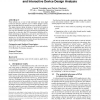EICS
2009
ACM
15 years 2 months ago
2009
ACM
Interactive computing systems frequently use pointing as an input modality, while also supporting other forms of input such as alphanumeric, voice, gesture, and force. We focus on...
EICS
2009
ACM
15 years 2 months ago
2009
ACM
EICS
2009
ACM
15 years 2 months ago
2009
ACM
We evaluated and compared four input methods using the Nintendo Wii Remote for pointing tasks. The methods used (i) the "A" button on top of the device, (ii) the "B...
EICS
2009
ACM
15 years 2 months ago
2009
ACM
Smart environments (e.g., airports, hospitals, stadiums, and other physical spaces using ubiquitous computing to empower many mobile people) provide novel challenges for usability...
EICS
2009
ACM
15 years 2 months ago
2009
ACM
The pervasive use of ambiguous keypads for mobile text entry necessitates examination of their performance characteristics. This paper presents TnToolkit – a self-contained tool...
EICS
2009
ACM
15 years 2 months ago
2009
ACM
This paper reports a usability evaluation of three operational digital libraries (DLs): the ACM DL, the IEEE Computer Society DL, and the IEEE Xplore DL. An experiment was conduct...
EICS
2009
ACM
15 years 2 months ago
2009
ACM
Usability-supporting architectural patterns (USAPs) were developed as a way to explicitly connect the needs of architecturally-sensitive usability concerns to the design of softwa...
EICS
2009
ACM
15 years 2 months ago
2009
ACM
This paper discusses the use of formal methods for analysing human-computer interaction. We focus on the mode confusion problem that arises whenever the user thinks that the syste...
EICS
2009
ACM
15 years 2 months ago
2009
ACM
The Open Interface Development Environment (OIDE) was developed as part of the OpenInterface (OI) platform, an open source framework for the rapid development of multimodal intera...
EICS
2009
ACM
15 years 2 months ago
2009
ACM
What methods can we use to help understand why users adopt certain use strategies, and how can we evaluate designs to anticipate and perhaps positively modify how users are likely...





